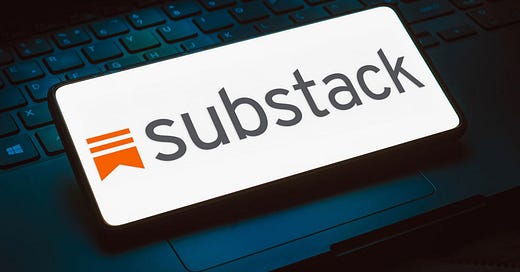TL;DR: After a few weeks of debate and some digging around, we’re happy to commit to staying on Substack for the foreseeable future.
Substack doesn’t have a ‘National Socialist’1 problem and its ease of use and its community-and-network-building tools are infinitely better and healthier than the alternatives. I’ve built and run at least four internet publishing and/or email subscription systems and helped roll out at least five others over the last 30 years, both here in Aotearoa-NZ and in Britain. I have some experience and skills to make a judgement on this issue and Substack does not have anywhere near the ‘N*zi problem’ suggested, or is likely to develop one.
Substack is far and away the simplest, cleanest, fairest, most efficient and least conflicted platform I’ve used to build safe and useful communities around news and analysis about politics and economics. Here’s the crux of it: paying subscribers can read, listen and comment on all the detail below the paywall fold and in the Chat function of the Substack app. This means the incentives for publishing and debate are so, so much healthier and more sustainable.
We’re not going to let a controversy over five substackers with barely a hundred active readers and no paying subscribers force us off a platform we have used to make a good honest living with a vibrant and constructive community.
For proof, subscribe and download the Substack app to look at the debates we’ve had amongst ourselves over the last couple of days. The quality of the commentary and interactions on Chat and in our comments on this and other issues has convinced me Substack is the place to stay, but there are more reasons below the paywall fold.
Elsewhere in the news in Aotearoa-NZ’s political economy today:
Green list MP Golriz Ghrahraman resigned this afternoon for mental health reasons. RNZ. Earlier it was reported the owner of Wellington gift store Cre8iveworxs sent an email to other stores in Wellington yesterday saying it had laid a shoplifting complaint with Police in October against Green list MP Golriz Ghrahraman, meaning there are now three such allegations being investigated, including two against her from Ponsonby Road boutique Scotties in Auckland. She returned from overseas yesterday. Stuff Glenn McConnell
In more signs of water infrastructure problems in growth cities, the Queenstown Lakes District Council reported effluent had overflowed from its Shotover Wastewater Treatment into a swamp nearby 1News, while Wellington moves to level two water restrictions tomorrow, partly because of a spike in demand from residents filling emergency water tanks. The Post-$$$ Julie Jacobson
Despite the reported deaths of 156 covid patients in the last four weeks as the highly-mutated JN.1 variant powers a fifth wave of infections, the Government is considering not paying for free facemasks and Rapid Antigen Tests from the end of February and ending free boosters this winter, in order to save money. NZ Herald Jamie Morton
Nauru announced it would seek a full resumption of diplomatic relations with China and cut ties with Taiwan. Reuters Kirsty Needham and Yimou Lee
Full paying subscribers can read and hear more detail in my Dawn Chorus podcast above and below the paywall fold. Join our community of paying subscribers to get access to ‘Hoon’ webinars, our private chat system and be able to comment on articles. Paying subscribers also support the public interest journalism we do at The Kākā on housing affordability, climate emissions and poverty.
Why The Kākā is staying on Substack
This is a post we’ve taken a few weeks to research, debate and write to make sure we can answer subscribers’ questions in the most deliberate and informed way. Thankyou to those who emailed and messaged with questions, especially for your patience. This post is the answer. Originally, we had hoped it wouldn’t be necessary and we would be able to begin 2024 focused on the housing, climate and poverty issues in Aotearoa-NZ. But the weight of questions about whether we would leave Substack, other articles and open letters by writers we respect, and a few cancellations, has forced us to address the issue over the last couple of days.
My default position on issues around free speech, extreme speech, hate speech and the politics of cancellation and censorship is to let it all go flying through the keeper. Debates about politics, democracy and the ethics and practicality of publishing bans and de-platforming quickly become toxic and mostly pointless. They are the definition of the blasts of noise erupting from the Internet that I try to sidestep and weave through without engaging. There’s nothing we could usefully say or do that would make a difference in any broad or even specific sense. Focusing on housing, climate and poverty here is something we can do that might make a difference. It’s also what we’re paid to do. That’s more important than most think, which we’ll touch on later.
This latest blast of noise erupted on November 28 via Jonathan Katz’s article in The Atlantic-gift, which accused Substack of hosting white supremacy and anti-semitic writers, and even more damningly, making money from them. A breezy read of the article would leave most with the impression there’s hundreds of extremists making good livings from subscriptions enabled and amplified by Substack, which is making loads of money from spreading the sludge that is corroding our democracies.
“Substack’s lax content moderation creates an opening for white nationalists eager to get their message out.
“The newsletter platform advertises itself as the last, best hope for civility on the internet—and aspires to a bigger role in politics in 2024. But just beneath the surface, the platform has become a home and propagator of white supremacy and anti-Semitism. Substack has not only been hosting writers who post overtly Nazi rhetoric on the platform; it profits from many of them.” The Atlantic-gift Jonathan Katz
Yikes. That got my attention, in part because I’m a subscriber to The Atlantic. One of the five gift article links I am entitled to monthly is above. Katz went on:
“At least 16 of the newsletters that I reviewed have overt Nazi symbols, including the swastika and the sonnenrad, in their logos or in prominent graphics. Andkon’s Reich Press, for example, calls itself “a National Socialist newsletter”; its logo shows Nazi banners on Berlin’s Brandenburg Gate, and one recent post features a racist caricature of a Chinese person. A Substack called White-Papers, bearing the tagline “Your pro-White policy destination,” is one of several that openly promote the “Great Replacement” conspiracy theory that inspired deadly mass shootings at a Pittsburgh, Pennsylvania, synagogue; two Christchurch, New Zealand, mosques; an El Paso, Texas, Walmart; and a Buffalo, New York, supermarket.
“Some Substack newsletters by Nazis and white nationalists have thousands or tens of thousands of subscribers, making the platform a new and valuable tool for creating mailing lists for the far right. And many accept paid subscriptions through Substack, seemingly flouting terms of service that ban attempts to “publish content or fund initiatives that incite violence based on protected classes.” The Atlantic-gift Jonathan Katz
This appeared to be an open-and-shut expose of the platform I use minute by minute to make my living from. We’re also aware of the toxicity and dangers of this sort of extremism. We’ve seen and received the ugliest of death threats and we’re just as aware of the Christchurch attacks as anyone else here. But by the time the article had cut through our various noise reduction filters, it was the summer holidays. Then in early January came the letters of protest from Substack writers I respected both here (Emily Writes Weekly) and overseas (Molly White’s Citation Needed). By early this week, a couple of the more successful and serious writers abandoned Substack altogether (Ryan Broderick’s Garbage Day and Casey Newton’s Platformer. Then John Naughton, a writer I respect and follow, wrote: ‘Publish N*zi newsletters on your plaform Substack and you will rightly be damned.’
We were also starting to receive questions from subscribers about whether or when we would leave Substack. A handful cancelled their subscriptions. So it’s clear this is not something The Kākā can just pad up to and hold its bat above its head2.
Katz was wrong and Substack is vastly better than the rest
The best place to start in any gnarly issue like this is to check the facts cited in saying ‘Substack has a N*zi’ problem’.
It turns out Katz was wrong with his suggestion hundreds of writers were making thousands of dollars in a system that was amplifying and spreading their sludge. He cited 16 newsletters he’d seen and suggested several were earning money from subscriptions, but did not document which ones and how much. Casey Newton went on to identify six Substacks he viewed as breaching Substack’s own terms of service with extremist content, and suggested there were enough making money to be worried about, and the beginning of a trend he didn’t want to be part of.
Upon receiving Newton’s list, Substack banned five of the six substacks, but he said he was still worried Substack would allow many more and he wasn’t going to stick around to find out:
“To be clear, there are a lot more than six bad publications on Substack: our analysis found dozens of far-right publications advocating for the great replacement theory and other violent ideologies.
“But until Substack makes it clear that it will take proactive steps to remove hate speech and extremism, the current size of the problem isn’t relevant. The company’s edgelord branding ensures that the fringes will continue to arrive and set up shop, and its infrastructure creates the possibility that those publications will grow quickly. That’s what matters.” Casey Newton via Platformer
So let’s look at the actual numbers, Substack’s actual terms of service and whether Substack actually is or will turn into an X-style hellscape. Substack does ban types of content and writers, including over nudity p*rn and credible threats to violence. It is also partnered with Stripe, which also won’t allow writers of these threats to receive payments, although they could still set up free sites.
It turns out the five banned substacks had barely 100 active readers and no (repeat nil) actual paying subscribers. One of the Substacks accused of being extremist was not banned and it does still offer subscriptions, but it is now inactive and was barely read when it was. For comparison’s sake, posts on The Kākā now often get over 50 likes and dozens of comments each. The extremist site’s posts were lucky to get one or two likes and no comments, even though they were turned on for all.
Compared to X, which the protest letter writers and Substack abandoners spend hours a day on, Substack is a relative Garden of Eden.
Substack’s creation of Notes and its algorythmically-curated weekly suggestions email has created the chance Substack readers and writers will be ‘pushed’ nasty stuff into their feeds and in-boxes, although my experience and the experiences of the thousands of subscribers to The Kākā (I asked them via Chat) is that this type of awful spam and harassment is infinitesimally rare. Compared to X, which the protest letter writers and Substack abandoners spend hours a day on, Substack is a relative Garden of Eden.
It’s true that Substack does not moderate either the posts on its platform or comments. That is up to the publisher and there are a whole range of tools, gradations of access and filters to help. But the biggest reason the comment and Chat threads are nowhere near as toxic as anything on X, Youtube, Facebook, Instagram and LinkedIn is that most publishers only allow paying subscribers to comment.
No ads and subscriptions change everything. For the better
It’s worth introducing some background on how The Kākā came to be and why our experiences building and running publishing, subscription and comment platforms on the Internet qualify us to make a judgement.
I helped create FTMarketwatch.com (since wound into FT.com) in the early 2000s with
I founded Reuters.co.uk and helped rebuild Reuters.com shortly after that. I was the Fairfax Head of Digital running Stuff in the mid-2000s. I co-founded Interest.co.nz and co-built two versions of its news and comment platforms in the late 2000s. Both allowed anonymous comments and were not paywalled.Then in 2012, I left Interest with a strong view that ad-funded journalism was not sustainable online and that email newsletter subscriptions were the best way forward. So I paid more than $50,000 to build my own more primitive version of Substack before Substack was even born. I worked with one of the founders of TradeMe and Xero to glom together an email publishing platform with a paywalled website and a user database that worked with Stripe. It required weeks of coding and testing, and then years of constant updates and maintenance, along with a few new features if I could afford.
It became Hive News and over five years we built up an audience of about 3,000 subscribers, both corporate and individual. They received a daily email and could access the articles with a user login and password that was connected to the user database to check if users had paid. Early on I decided not to allow comments from either free or paying subscribers, partly because of a dearth of readers initially and also because I didn’t have the time to moderate them on my own. I saw what open slather comments meant from my time at Interest. Never again. But I also saw how hard it was to be discovered and widely read when everything was behind a paywall, there was no community and the articles couldn’t be easily shared through social media.
By 2017, I decided to move on and try to create something bigger that everyone could read, if not comment on. I co-founded the current version of Newsroom.co.nz with Tim Murphy and Mark Jennings. I created and ran the Newsroom Pro side of the operation, which published a paid-subscriber-only email with articles that were paywalled. We redeveloped the site from 2019 onwards so paying subscribers only could comment. I’m still a shareholder in Newsroom and am incredibly proud of its progress and how it continues to thrive. That is partly because the site is not as ‘noisy’ and ugly as Stuff, NZ Herald and Newshub, largely because Newsroom does not allow anonymous comments from non-paying subscribers and is paid for by a mix of sponsorship and subscriptions, rather than flashing, over-bearing display advertising.
By 2020 I was aware of Substack and could see it was a much, much better version of Hive News. It had essentially become a ‘software as a service’ type platform for publishers wanting to make a living from subscriptions, rather than advertising. That’s why we started to publish The Kākā on Substack from late 2020 onwards. We turned on the paywall in late 2021 and have thrived ever since, mainly because of the new features constantly being developed, tested, maintained and debugged. They include the writers recommendations feature, Chat, Notes and the addition of audio and video. Substack’s features allow us to try out giving some things away, giving a part of articles away, and then opening things up later. I often dreamed of these features at Hive News, but could never imagine having the skills or funds to create them.
I suspected that changing the incentives for publishers and readers by relying on subscriptions rather than ads would transform everything, including:
incentivising the creation of substantial articles that favoured reliability and accuracy over sensation or ‘click bait’;
encouraging writers and readers to talk to each other directly in respectful and human ways that were constructive and hopeful, rather than just plain nasty and depressing; and,
encouraging a long-term approach to publishing and audience building that understands readers, listeners and subscribers want useful, thoughtful and enlightening content that stands the test of time.
We can see the fruits of that after three years publishing on Substack and over two years with subscriptions turned on. It is a viable platform for us that makes us feel good every day about the work we do for the people who subscribe.
We’re not going to let a controversy over five substackers with barely a hundred active readers and no paying subscribers force us off a platform we have used to make a good honest living with a vibrant and constructive community. The alternatives now simply don’t have the features and the ability to create a network effect. We know what the alternative looks like because we’ve been there and it’s not as good. It’s good to see Substack step up and remove those publishers that have breached its rules and I hope both it and Stripe remain vigilant.
I’m no free-speech absolutist and I am just as sceptical as others about tech bros spouting libertarian mantras about the glory of tech solving the world’s problems. But I don’t think Substack’s systems or values encourage or create the sorts of hellscapes that first Facebook and now X have became. That’s because of the centrality of subscriptions and the lack of advertising.
It’s also because the platform is built for readers and writers to be together safely and in a human way. It’s not for advertisers and shareholders who want and need to create tribes of outrage addicts to make money. Substack makes money when readers and subscribers do something useful and meaningful for each other: publish articles, podcasts and videos that readers and viewers are happy to pay regularly to receive and read in pleasant places they can control.
We’re staying on Substack and we hope you’ll stay with us too.
Timeline cleansing nature pic of the day
Ka kite ano
Bernard
I’m going to try avoiding using that shorter word starting with N that includes a Z and an I for the simple reason I worry a lot about email system spam filters. It is a trigger word.
Eds: that’s enough cricketing metaphors for today.














Share this post